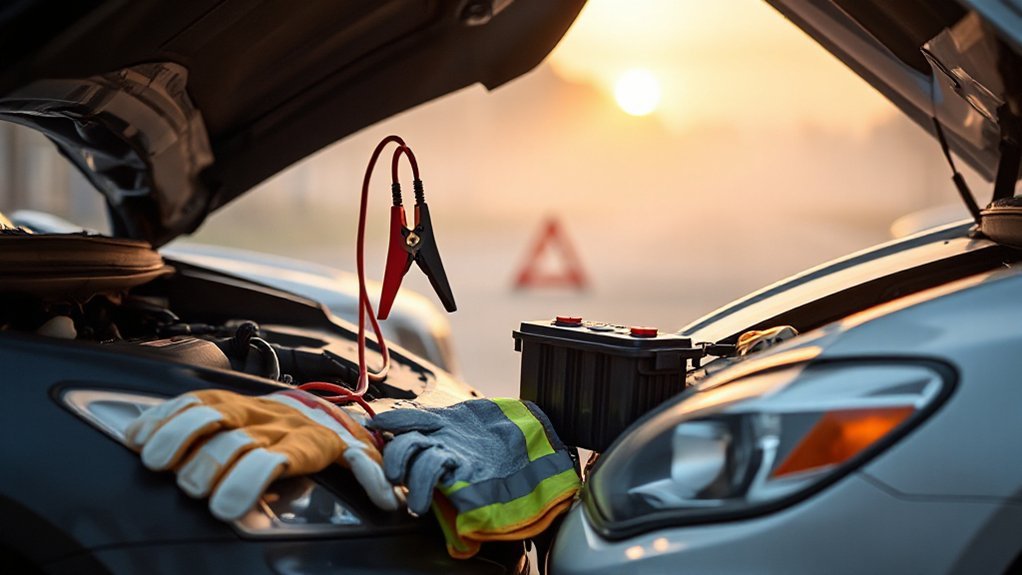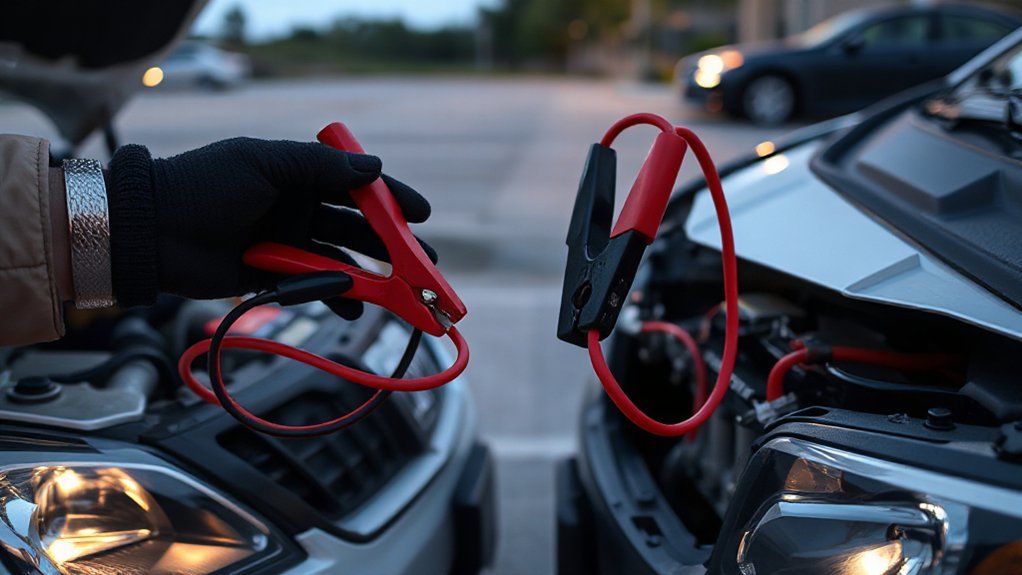You’ll want to confirm the vehicle is in park (or neutral), the parking brake is on, and there’s no obvious battery damage before you touch anything. Gather insulated jumper cables or a portable starter and eye protection, then follow a precise cable sequence to avoid sparks and short circuits. If you do it correctly you’ll get the engine turning over — and if it doesn’t, there are a few quick diagnostics to try next.
Key Takeaways
- Park the donor vehicle close, set both cars in park/neutral with parking brakes, engines and accessories off, and remove keys.
- Connect red clamp to the dead battery’s positive terminal, then to the donor battery’s positive terminal.
- Attach black clamp to the donor battery’s negative terminal and the other black clamp to an unpainted metal ground on the dead vehicle.
- Start the donor car, let it idle about three minutes, then try starting the dead vehicle; avoid over-cranking.
- Once started, remove clamps in reverse order, keep the revived car running for 20–30 minutes to recharge the battery.
What to Check Before You Begin

Before you touch the cables, verify the situation and risks: confirm both vehicles are in park (or neutral with parking brakes set), engines off, keys removed, lights and accessories switched off, and batteries accessible and free of obvious damage or leaks. Next, assess battery condition — look for swelling, corrosion, or fluid leakage. If you see physical damage or strong odor, don’t proceed. Check electrical connections at both battery terminals: make sure clamps, posts, and wiring are clean, tight, and free of heavy corrosion that could impede current flow. Verify the dead battery’s terminals match the booster vehicle’s polarity. Confirm no nearby flammable materials or electronic devices that could be affected. Only continue once batteries and electrical connections present no visible hazards.
Tools and Safety Equipment You’Ll Need

You’ll need a small kit of reliable tools and safety gear to jump a car safely: heavy-duty jumper cables (at least 4–6 gauge, 8–12 ft), insulated gloves, safety goggles, and a flashlight with fresh batteries. Add a vehicle-rated portable jump starter, a basic wrench set for battery terminals, and a battery terminal brush. These essential tools let you establish secure electrical connections and inspect terminals.
Follow safety precautions: work in a ventilated area, park both vehicles with engines off and parking brakes engaged, and keep metal objects away from the battery. Don’t smoke or allow sparks near the battery. Verify cable insulation and clamp integrity before use. Store components in a compact bag so you can access and deploy the kit quickly and safely.
Step-By-Step Jump Starting With Jumper Cables

When both vehicles are positioned, engines off and parking brakes set, connect the jumper cables in the correct order to prevent sparks and damage: attach the red clamp to the positive (+) terminal of the dead battery, then to the positive (+) terminal of the donor battery; attach the black clamp to the negative (−) terminal of the donor battery, and finally attach the remaining black clamp to an unpainted metal ground on the dead vehicle away from the battery (engine block or chassis). Start the donor engine, let it idle three minutes, then attempt to start the dead vehicle. If it starts, idle both vehicles for several minutes before disconnecting in reverse order: remove grounded black clamp first, then donor negative, donor positive, and dead positive. These jump starting techniques reduce sparks; avoid common mistakes like reversing polarity or grounding to battery terminals.
Using a Portable Jump Starter Safely
One compact portable jump starter can get you moving without another vehicle, but you must follow safety and connection protocols precisely. Inspect the unit and clamps for damage, confirm charge level, and read the manufacturer’s quick-start. Park on level ground, set parking brake, and switch off ignition, accessories, and electronics. Identify positive (+, red) and negative (-, black) terminals on the battery. Attach the red clamp to the positive terminal first, then attach the black clamp to a metal chassis ground away from the battery and fuel system. Do not connect black to the negative battery terminal if manufacturer warns otherwise. Engage the starter per device instructions, avoid cranking overlong, and disconnect clamps in reverse order. Observe safety precautions: gloves, eye protection, and keeping clear of moving parts.
Troubleshooting When the Car Still Won’T Start
If the engine still won’t crank after a successful jump or portable starter, don’t assume the battery was the only issue—systematically isolate the problem by checking starter engagement, ignition and security circuits, fuel delivery, and engine management faults. First verify battery issues: measure voltage at rest and while cranking; ascertain good clamp contact and correct ground. Next assess for electrical problems: inspect fuses, relays, harness connectors, and security immobilizer indicators. Test for starter malfunction: listen for solenoid click, bench-test starter, and verify voltage at the starter while attempting start. Evaluate the fuel system: confirm fuel pump prime, fuel pressure, and injector operation. Finally scan for engine codes with an OBD-II reader. If tests are inconclusive, call a technician.
Conclusion
Before you try to jump, confirm both cars are in Park (or Neutral), engines off, and parking brakes set. Wear gloves/eye protection and have heavy‑gauge jumper cables or a portable starter. Attach red to positive terminals, black to donor negative, and the other black to a clean metal ground on the dead car. Start the donor, wait a few minutes, then start the dead car. If it won’t start, check connections, battery condition, and fuses before repeating.